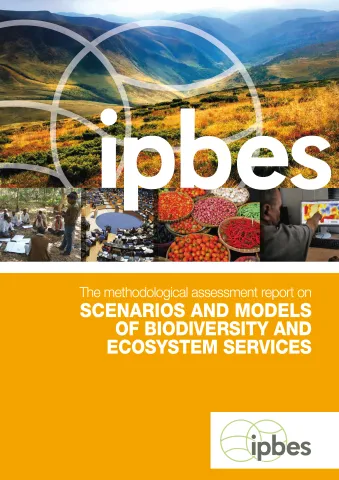Scenarios and models assessment

Methodological Assessment Report on Scenarios and Models of Biodiversity and Ecosystem Services
The Scenarios and Models Assessment, published in 2016, presents a best-practice 'toolkit' for the use of scenarios and models in decision-making on biodiversity, human-nature relationships, and the quality of life. The 'toolkit' helps governments, private sector, and civil society to anticipate change - such as the loss of habitats, invasive alien species, and climate shifts - to reduce the negative impacts on people and to make use of important opportunities.
The Plenary approved the Summary for Policymakers and accepted the chapters of the Assessment at its 4th session in February 2016 in Kuala Lumpur, Malaysia (IPBES 4).
The Scenarios and Models Assessment guides the use of methodologies in all IPBES work and has also made a significant global impact – for instance at the 13th meeting of the Conference of the Parties to the Convention on Biological Diversity (CBD COP13) in Mexico, in 2016, where the COP recognized the relevance of the Assessment for the 5th edition of the Global Biodiversity Outlook and listed it among the best available scientific information. The COP also encouraged Parties, other Governments, relevant organizations, the scientific community, stakeholders, as well as indigenous peoples and local communities to develop and use these tools and to contribute to their further development.
IPBES would like to acknowledge and thank all of the experts who contributed to the Assessment.
Editor: Simon Ferrier, Karachepone N. Ninan, Paul Leadley, Rob Alkemade
Members of the management committee who provided guidance for the production of this assessment: Paul Leadley (Multidisciplinary Expert Panel) and Jay Ram Adhikari (Bureau).
Suggested citation: IPBES (2016): The methodological assessment report on scenarios and models of biodiversity and ecosystem services. S. Ferrier, K. N. Ninan, P. Leadley, R. Alkemade, L. A. Acosta, H. R. Akçakaya, L. Brotons, W. W. L. Cheung, V. Christensen, K. A. Harhash, J. Kabubo-Mariara, C. Lundquist, M. Obersteiner, H. M. Pereira, G. Peterson, R. Pichs-Madruga, N. Ravindranath, C. Rondinini and B. A. Wintle (eds.). Secretariat of the Intergovernmental Science-Policy Platform on Biodiversity and Ecosystem Services, Bonn, Germany. 348 pages. https://doi.org/10.5281/zenodo.3235428